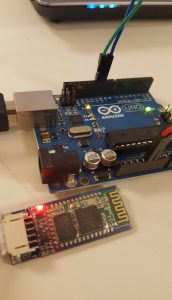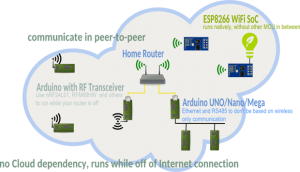ABSTRACT
Internet of Things (IoT) is the interconnection via the Internet of computing devices embedded in everyday objects, enabling them to send and receive data. IoT applications can vary from collecting small scale data such as room temperature, to something as big as collecting personal health information and enabling us to keep track of our personal fitness without having to go to the doctor. This research project involves making master and slave node embedded circuits, combined with several different physical and environment sensors, as well as developing program code to make everything work together. The slave nodes send the sensor data to the master node wirelessly and the master node forwards the sensor data to IoT analytics web-site on the Internet that decides an output action. Electrical circuits, computer hardware, software programing and wireless networking knowledge gained from the classroom and laboratory is employed in this research project to develop key components of a small scale Internet of Things framework, by using open source software and low cost open source computer hardware devices.
Electrical Components, Software’s And Materials
Funduino Sensor Sheild: The Sensor Shield’s purpose is make it easy to connect cables and devices to the correct Arduino pins. It is not an active device. It simply connects the Arduino pins to many connectors that are ready to use to connect to various devices like Servos and Sensors with simple cables
Bluetooth Sensors: The bluetooth sensors allow us to connect with the internet, and to transfer all the data we recieve, to the web.
Blueterm: An app used for the bluetooth to connect to the device built to report any changes, and to transfer data over to the web through the laptop.
Arduino Nano: The Arduino Nano is a small, complete, and breadboard-friendly board based on the ATmega328 (Arduino Nano 3.x). It has more or less the same functionality of the ArduinoDuemilanove, but in a different package. It works with a Mini-B USB cable instead of a standard one.
Humidity and Temperature Sensor: The DHT11 is a basic, ultra low-cost digital humidity and temperature sensor. It uses a capacitive humidity sensor and a thermistor to measure the surrounding air, and outputs a digital signal on the data pin
PROGRAMMING
In this program written in Arduino C++ language, the connections to the hardware devices are defined first. Then the
communication interface is initialized in the setup() function. The loop() function measures humidity and temperature
and transmits the measured values to a mobile device through the communication interface (Bluetooth module).
Shown below is a connection diagram of how the Bluetooth module pins are connected to Arduino Nano. The Vcc from Bluetooth module is connected to 5V pin on the Nano, the GND is connected to GND, and TXD and RXD are
connected to RX0 and TX1 respectively.
FLOW OF INFORMATION
In the next phase of this research project the ESP8266 WiFi modules will be used to connect multiple Arduino based sensors (slave devices) to a wireless router (master device). The accompanying diagram shows how the flow of
information is carried out in this setup. The Arduino Nano is connected to the wireless router with the help
of ESP8266 WiFi transceiver module. The humidity,temperature and other environment sensor measurements and data is sent to a server on the Internet (through the wireless router) where it is stored, analyzed and displayed on a web page.
CONCLUSION
This is just the first phase of a research project where the IoT devices tell you the changes in temperature and humidity in the environment. The future goal of this project is to implement the idea of IoT in a way which is beneficial for everyone. It will show how we can take technology to a whole new level, and create things which will not only be more environmental friendly but will also benefit other people in many ways. These devices will not only let you see the humidity and temperature changes, but will also tell you by how much they have changed. This IoT system will allow you to send the environment data to a web page and compare the results. It will show in what ways do the environmental changes effect the results. Further continuation of this project can lead us to build IoT devices to inform us of dramatic changes which cause natural disasters.
REFERENCES
- Arduino web page : https://www.arduino.cc
- Arduino programming reference : https://www.arduino.cc/en/Reference/HomePage
- Cooking Hacks: https://www.cooking-hacks.com/documentation/tutorials/how-to-send-sensor-data-through-the-serial-port-profile-using-bluetooth/
- Nordic Develepor Zone: https://devzone.nordicsemi.com/question/30607/getting-data-from-external-hw-and-sending-over-ble/






